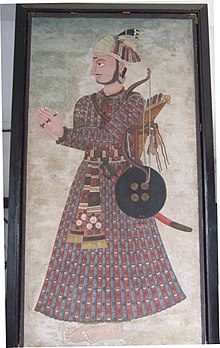Jaya Prakash Malla (Newar: 𑐖𑐫𑐥𑑂𑐬𑐎𑐵𑐱 𑐩𑐮𑑂𑐮) was the last king of Kantipur (Newar: यें) which corresponds to present-day Kathmandu. He ruled from 1736 to 1746 after succeeding his father Jagajjaya Malla, and then from 1750 until his death in 1769.[1]
| Jaya Prakash Malla | |
|---|---|
 | |
| King of Kantipur | |
| Reign | 1736–1746 |
| Predecessor | Jagajjaya Malla |
| Successor | Jyoti Prakash Malla |
| Reign | 1750–1768 |
| Predecessor | Jyoti Prakash Malla |
| Born | Kantipur, Nepal |
| Died | 1769 Pashupatinath |
| Dynasty | Malla dynasty |
| Father | Jagajjaya Malla |
| Signature | |
Early life
editJayaprakash Malla's elder brother and the heir apparent of Kantipur Rajendra Malla died when he was young. Some courtiers and nobles requested the king to declare Jayaprakash's younger brother Rajyaprakash the heir instead of Jayaprakash. Jayaprakash's rivalry with the nobles began after the king decided that Jayaprakash would succeed him after his death.[1]
Reign
editConflict with brothers
editHe ascended the throne after his father died in 1736. Suspecting a coup from his brother and the nobles, he expelled his brother Rajyaprakash during the time of mourning for his father. Rajyaprakash was adopted as the heir by Vishnu Malla, the then King of Patan.[2][3]
After a short while, some palace officials conspired and proclaimed his younger brother Narendraprakash as the ruler of the north-eastern part of the kingdom. Jayaprakash defeated Narendraprakash after four months and Narendraparakash fled to Bhadgaon where he died.[1][2]
In 1737, Narabhupal Shah of Gorkha attacked Nuwakot but was quickly defeated by Jayaprakash Malla.[1]
In 1744, Prithvi Narayan Shah attacked Nuwakot again and annexed it from Kantipur.[1][4]
When Prithvi Narayan Shah attacked Nuwakot, a protectorate of Kantipur, Jayaprakash sent troops under Kashiram Thapa. The battle occurred in 1746 where Kashiram Thapa lost the war and Jayaprakash Malla thought of deceit.[5][6] Jaya Prakash Malla was angered and killed him.[7][8] In the day of Indrajatra, when there was festival going on, Prithvi Narayan Shah attacked Yen (Kantipur). Jaya Prakash Malla was helpless and he went to Lalitpur to seek asylum. Tej Narasimha Malla ruled that kingdom. After some time Prithvi Narayan Shah attacked Lalitpur and Jaya Prakash Malla along with Tej Narasimha Malla ran to Bhaktapur to seek asylum. When Prithvi Narayan Shah attacked Bhaktapur, Ranajit Malla surrendered. Later, Ranajit Malla was sent to Kashi to spend rest of his life; Jaya Prakash Malla died and Tej Narasimha Malla was kept in lifetime detention.[9]
Literary works
editHe contributed to the literature of Nepal Bhasa with works such as "Padma Samuchaya" and three dramas that were concerned with Hindu mythology being Ratneshwar Pradurbhav, Birdhwojopakhyan Natakam and Bhairavpradurbhav.[10]
References
edit- ^ a b c d e Regmi, Mahesh C. "Regmi Research Series". German Oriental Society. 5: 125–130.
- ^ a b Wright, Daniel (1877). History of Nepal (PDF). University of Cambridge. pp. 223–232.
- ^ Shrestha, D.B.; Singh, C.B. (1972). The History of Ancient and Medieval Nepal (PDF) (1st ed.). Kathmandu: University of Cambridge. pp. 42–49.
- ^ Shaha, Rishikesh. Ancient and Medieval Nepal (PDF). Kathmandu, Nepal: University of Cambridge. pp. 65–78.
- ^ Vaidya, Tulsi Ram (1993), Prithvinarayan Shah, founder of modern Nepal, Anmol Publications, p. 144, ISBN 8170417015
- ^ Aryal, I. R.; Dhungyal, J. P. (1975), A new history of Nepal, Voice of Nepal, p. 78
- ^ Thapa, Krishna B. (1989), Unification of Nepal:A change in inter-intra relations, AKAA publishers, p. 36
- ^ Shaha, Rishikesh (1990), Modern Nepal 1769-1885, Riverdale Company, p. 27, ISBN 0913215643
- ^ Giuseppe, Father (1799). Account of the Kingdom of Nepal. London: Vernor and Hood. p. 322. Retrieved November 23, 2012.
- ^ Vaidya, Janaka Lāla (2002). Nepāla bhāshāyā prācīna kāvya sirjanā : pulāṅgu meyā vyākhyā, viśleshaṇa va samīkshā yānā taḥgu anusandhāna saphu. Yeṃ: Nepāla Rājakīya Prajñā-Pratishṭhāna. ISBN 99933-50-32-X. OCLC 52853578.
Further reading
edit- Regmi, Mahesh Chandra (1978). Regmi Research Series.
- Khatri, Shiva Ram (1999). Nepal Army Chiefs:Short Biographical Sketches. Sira Khatri.
- Regmi, D. R. (1975). Modern Nepal vol.1. Firma KL Mukhopadhyay. ISBN 9780883864913.